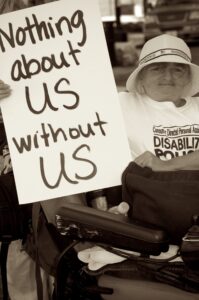The UN Convention on the Rights of Persons with Disabilities continues to be little known, and therefore little implemented, even in those countries (such as Italy) that have ratified it. Sometimes access to information is precluded to people with disabilities themselves, who are unable to access information in ways commonly used by other people. To make up for this gap, several entities have translated the UN Convention into different languages and made these versions available online. While ‘Diritti alla Follia’ Organization is promoting “UnsilenceYourVoice,” an innovative international project that, among other things, invites people with psychiatric experience to artistically reinterpret the UN Convention in light of their own experiences.

In the U.N. Convention on the Rights of Persons with Disabilities (ratified by Italy with Law 18/2009) there are no less than two articles that spell out in specific terms the right of persons with disabilities to access information: article 9 (Accessibility) and article 21 (Freedom of expression and opinion and access to information). In particular, the latter requires that «all appropriate measures be taken to ensure that persons with disabilities can exercise their right to freedom of expression and opinion, including the freedom to seek, receive and impart information and ideas on an equal basis with others and through any media of their choice». The problem is that paradoxical situations arise in reality. In fact, people with disabilities who have complex communication needs, and therefore are unable to access information in the ways commonly used by other people, may never be able to discover that they have this right, and therefore to demand it, if the Convention is not provided in languages and forms appropriate to their needs. Which, however, happens very rarely.
To make up for this shortcoming several bodies have translated the UN Convention into different languages and made these versions available on the Web. We highlight a few of these translations. Anffas (National Association of Families and Persons with Intellectual Disabilities and Neurodevelopmental Disorders), for example, has produced the version in language that is easy to read and understand (easy to read, available at this link), and also one with augmentative alternative communication (AAC) symbols, available at this other link. Not only that, this organization has also translated into easy to read the Concluding Observations to Italy’s first report on the implementation of the Convention produced, in 2016, by the UN Committee on the Rights of Persons with Disabilities, the body responsible for overseeing the implementation of this treaty in countries that have ratified it (they are available at this link). There is also a version of the Convention in Italian Sign Language (ISL), which can be viewed on YouTube at this link, and was produced by LaCAM (Language and Communication Across Modalities Laboratory) and Gruppo SILIS (Gruppo per lo Studio e l’Informazione sulla Lingua dei Segni Italiana). Another version of the CAA Convention is the one produced by Simona Piera Franzino and Domenico Massano, editors of the blog “la sCAAtola,” and is available at this link. All these versions have no official character, are a reworking of the original text of the UN Convention, and have been produced to meet the needs of people with complex communicative needs, but also foreign people who do not speak Italian well, people with learning disabilities, etc., thus helping to ensure that the rights enshrined in the Convention become accessible, visible, and therefore claimable and enforceable, by those very people for whom it was written and who, paradoxically, risk being excluded from knowledge.
Yet there is a further level of disclosure of the UN Convention, and that is to relive it by reinterpreting it artistically in the light of one’s own experience. And that is what “UnsilenceYourVoice” (literally: Do not silence your voice), an innovative international artistic-legal project aimed at people with psychiatric experience, which is the brainchild of Annemarie Arnold, a member of ENUSP (European Network of (ex)Users and Survivors of Psychiatry), and here in Italy is reproposed in collaboration with Diritti alla Follia, an organization committed to promoting the rights of people with psycho-social disabilities. The initiative aims to induce people with psychiatric experience to recount their experiences through art, and, precisely, to raise awareness of the UN Convention, having noted how it, unfortunately, continues to be little known by those entitled to it even in countries that have ratified it (a background note on the project can be found at this link).
The challenge therefore is not only to popularize the UN Convention on the Rights of Persons with Disabilities, but also to make it accessible, visible and livable. If we find “book men” in literature (Ray Bradbury’s Fahrenheit 451, 1953), we could reinvent ourselves as “Convention men and women.” If presented this way, it certainly would not go unnoticed. (Simona Lancioni)
Note: we thank Cristina Paderi for the solicitation from which this reflection arose and for having taken care of the translation of the text into English.
Ultimo aggiornamento il 8 Giugno 2024 da Simona
